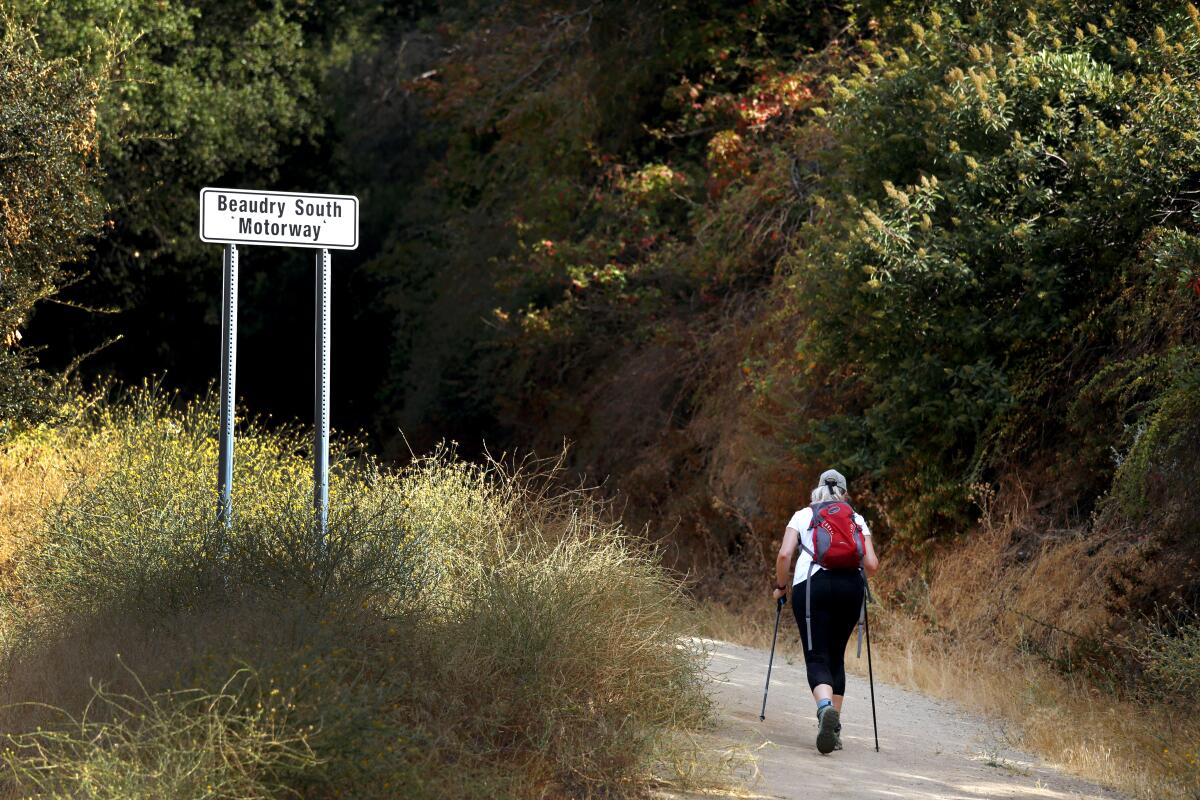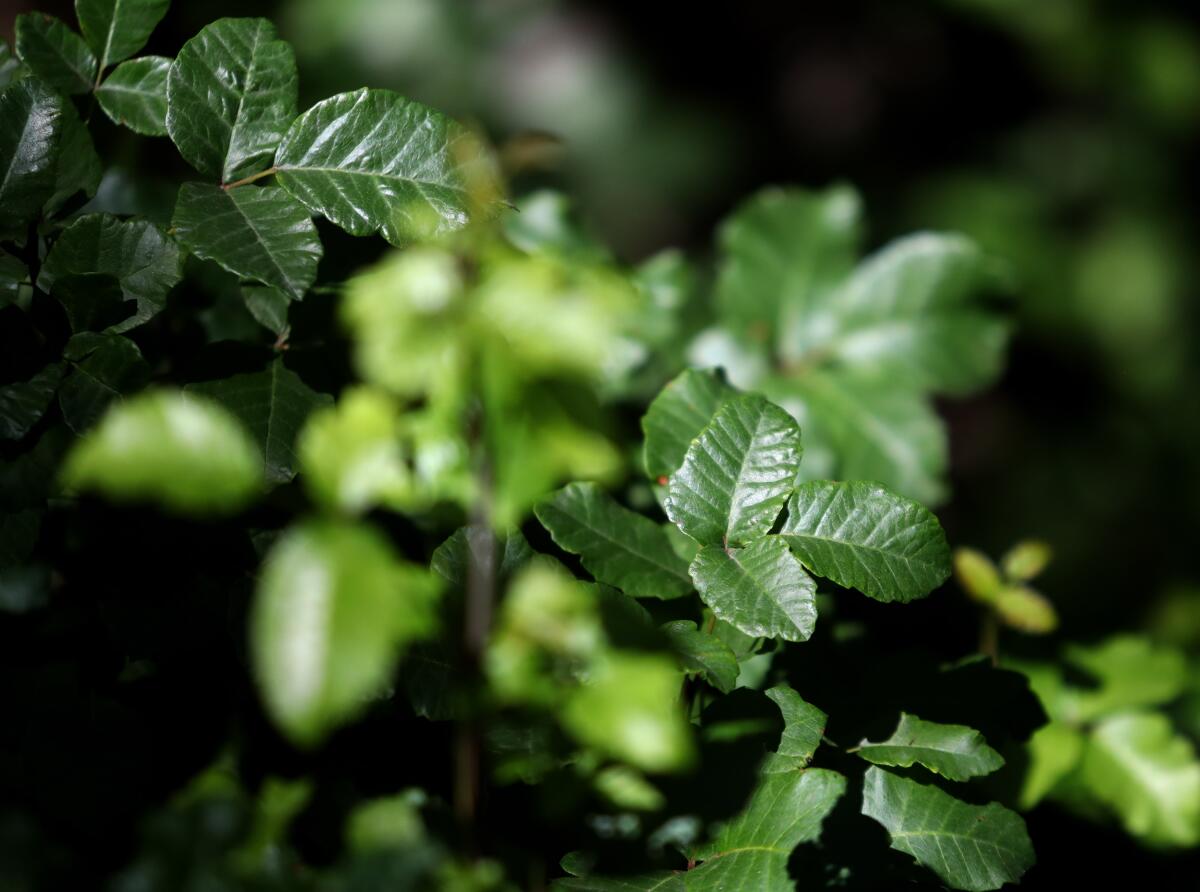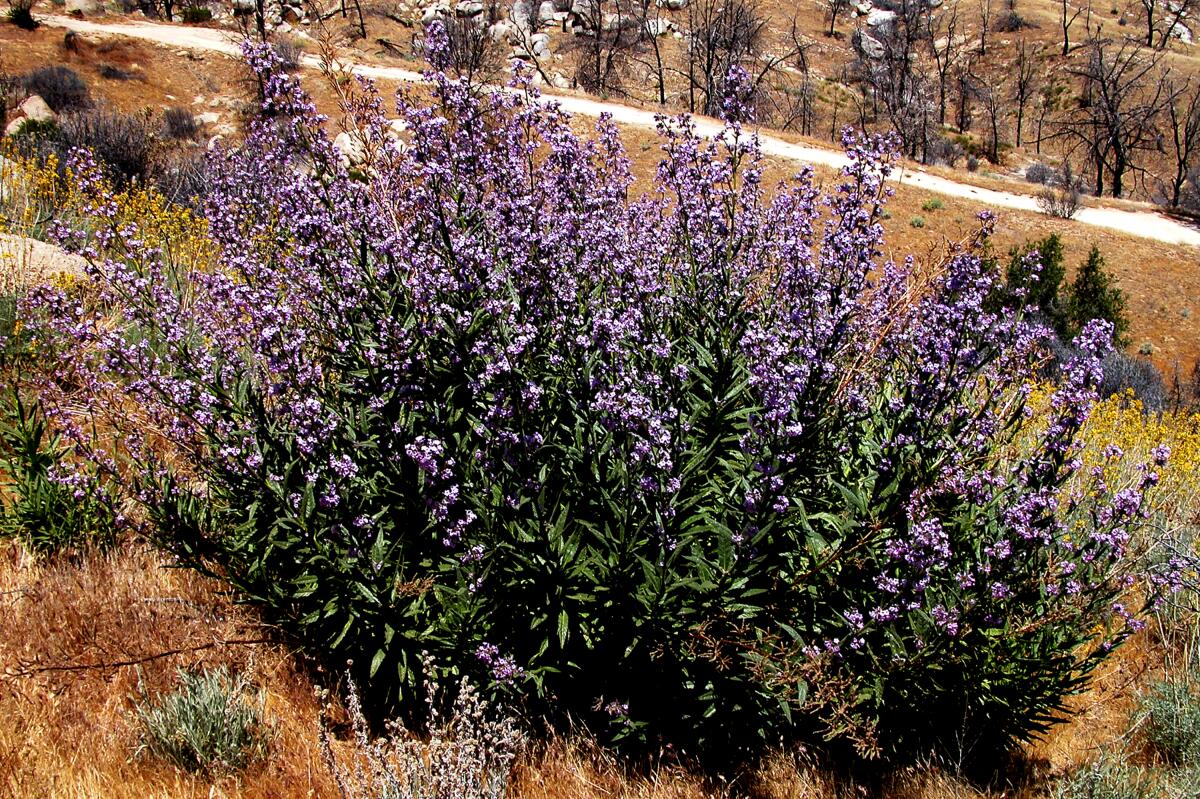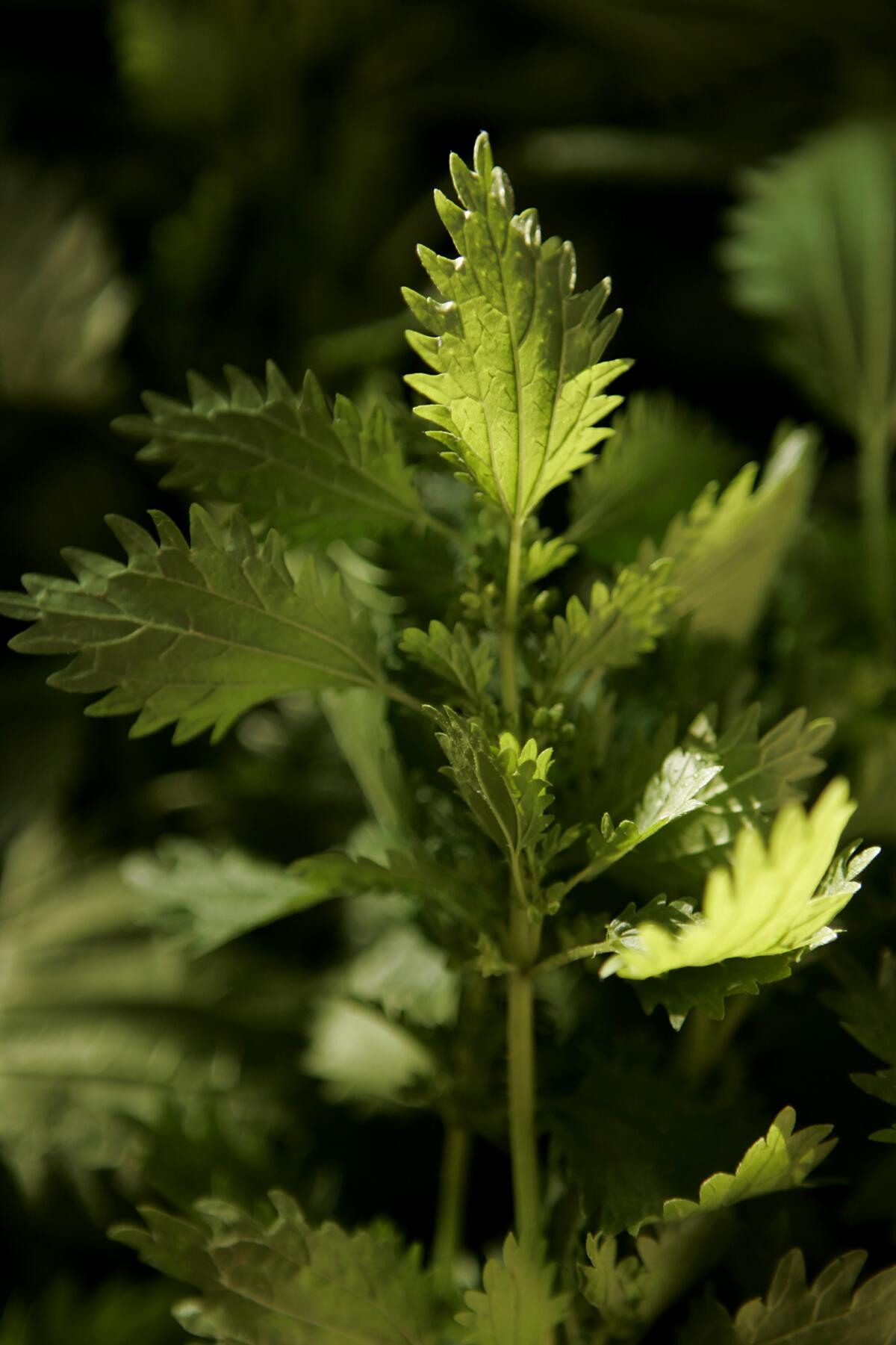Itching to hike? Avoid these plants or you’ll be scratching for days

- Share via
Over Memorial Day weekend and next week’s National Trails Day, thousands of Southern Californians will head into the great outdoors for some sun, exercise and natural beauty — and in many cases, a nasty rash.
Unusually heavy rainfall this past winter has helped many a native plant, wildflower and, yes, poisonous weed along Southern California’s hiking trails to grow and extend its greenery “almost like it wants to reach out and shake your hand because it’s sticking out everywhere,” said Cris Sarabia, conservation director for the Palos Verdes Peninsula Land Conservancy.
Land managers are a little behind on clearing the pathways, so that’s why you’re seeing overgrown foliage, Sarabia said.
As you prepare to hit the trails, experts urge you to take precautions with the vegetation that causes skin irritation, rashes and, in some severe cases, respiratory issues.
But don’t let these plants deter you from enjoying the outdoors. Instead, do some research on your destination before you head out, said Wesley Trimble, communications director for the American Hiking Society.
Here’s some advice from outdoor enthusiasts and experts about which native plants to avoid on your walks and how to treat skin that’s made contact with a poisonous plant. They also shared resources to level up your vegetation ID skills.
Whether you’re looking for ocean views or desert landscapes or soaring mountain peaks, Los Angeles offers miles upon miles of strikingly different trails.
Poisonous plants to avoid while hiking
There are at least two common types of poisonous plants on trails that can cause skin irritation and in some severe cases respiratory issues: poison oak and poodle-dog bush. There’s also a less pervasive threat, stinging nettle.

Poison oak can be challenging to identify, said Trimble, because it can grow like a shrub, long vines, or underbrush.
“It likes to grow in disturbed soils, meaning areas that are trafficked, like trails, or disturbed by ecological changes,” he said.
There are several ways to look out for poison oak, starting with the old adage, “Leaves of three let it be,” Trimble said. It’s an accurate depiction of the plant, whose fuzzy green, scalloped-edge leaves grow in clusters of three. Sometimes the plant also has yellow-white or tan colored berries.
“When folks take breaks — if you’re going to sit down alongside the trail, for example — really be careful of where you’re sitting, because in a more shady area [poison oak] tends to grow more as an underbrush or overgrown as vines,” Trimble said.
If you come into contact with the plant, the Food and Drug Administration advises that you wash your skin, clothing and equipment with cool soapy water as soon as possible. You may be able to rinse off some of the plant oil.
How to treat it: You can treat the rash at home if you have a mild outbreak on the skin. The American Academy of Dermatology Assn. advises that you go to the emergency room if you have the following symptoms, which are signs of a severe reaction:
- Difficulty breathing or swallowing
- A rash around one or both eyes or your mouth, or on your genitals
- Swelling on your face, especially if an eye swells shut
- Itching that worsens or makes it impossible to sleep
- Rashes covering most of your body
- A fever
When a mild blister or rash starts to form on the skin, don’t scratch!
Bacteria under your fingernails can get into the rash and cause an infection, according to the federal agency. Relieve the itching sensation by soaking the affected skin in cool water or using a cold compress.
You can use calamine lotion or over-the-counter hydrocortisone cream to reduce or alleviate the itch. UCLA Health also recommends using steroid cream or bathing with baking soda or colloidal oatmeal. It also said your healthcare provider may prescribe an antihistamine that doesn’t relieve the itching but may help you sleep (and ignore the itching).
To aid the healing process you can also purchase a bottle of Tecnu, a cleanser that washes away the poison oak oils you managed to get on your skin.
If your rash doesn’t improve in seven to 10 days, the dermatology association says, your skin may have become infected, so you should see a board-certified dermatologist.

Poodle-dog bush, another native poisonous plant, sprouts after a forest or brush fire, which is why it’s also known as the “fire follower,” according to the U.S. Forest Service.
This plant tends to give people a more intense allergic skin reaction than poison oak, said Trimble.
It grows in a grouping of extended, thin leaves that are often a foot long. In June through August the plant grows a purple bell-shaped flower.
“The plant is covered in sticky hairs, which can dislodge easily and can be passed onto hikers who touch it or brush up against it,” according to the Forest Service.
The plant also has a pungent smell.
If skin comes into contact with the plant, swelling, rash and itching can appear in between 12 hours and two days.
How to treat it: As with poison oak rash, use a cold compress, apply calamine lotion or bathe in baking soda or colloidal oatmeal to relive itching symptoms.

Stinging nettle is a less common weed that pops up on some trails. It grows in moist and uncultivated areas, including riverbanks, fence rows and roadsides, according to the University of California Agriculture and Natural Resources pest management program. It’s a broadleaf weed that grows in colonies or large groups and have seed leafs that are round and oval with sparse stinging hairs.
Skin that comes into contact with the weed rapidly develops reddish patches and starts itching.
How to treat it: There isn’t a treatment plan other than steps you can take to relieve the itching, including using a cold compress, applying calamine lotion or bathing in baking soda or colloidal oatmeal.
Poison ivy is a well-known threat in many parts of the country, but Trimble and Sarabia said it’s not prevalent in Southern California. #Winning.
Why hike in Los Angeles? Lots of reasons. Use our guide to navigate 50 trails in Southern California, plus tips on gear and treats for the trail.
Know your plants ahead of your trek
The first preventive measure to take on a hike is to wear long sleeves, long pants, long socks and closed-toe shoes. You can also try IvyX, a product that you spread on your skin to act as a poison oak and poison ivy barrier. It comes in the form of towelettes or gel.
On the trail, avoiding poisonous plants starts with getting to know them. Sarabia suggests hikers of all levels learn a plant a day.
You can start your plant educational journey by looking through Calscape, the California Native Plant Society’s online database that offers 150 years’ worth of knowledge on native plants in your area.
Sarabia also suggested iNaturalist, an online community where users share what they’ve learned about nature. You can record your findings, connect with experts and create useful data for scientists and resource managers.
Part of this research includes getting to know the trail you want to visit.
“For folks who aren’t super familiar with areas beyond just poisonous plants, there’s going to be other ecological conditions that may present hazards on the trail,” Trimble said.
You can learn more about trails in Southern California by visiting a city’s parks and recreation website, the L.A. County trails website or the Angeles National Forest website.
Another online resource is AllTrails, which includes details about and people’s reviews of your destination.
“People sometimes in reviews will say, ‘Hey, I saw a lot of poison oak on this section of the trail,’” Trimble said. “So even if people aren’t familiar with identifying the plant, it might be a good way to be kind of cautious.”
Lastly, find your local nature center or outdoor group. The California Native Plant Society, for example, has 35 chapters, and each typically has monthly meetings in-person or online with programming whose topics include plants and local hikes.
Try these dozen routes to make you — and your pup — happy hikers.
Here are more ways to connect with Southern California groups and hiking resources:
- Become a member of the Sierra Club Angeles Chapter that covers Los Angeles and Orange counties.
- Check out Latino Outdoors programming that centers on fostering outdoor engagement by Latinos and other communities.
- Get back in touch with nature through Outdoor Afro‘s recreational programming, which is focused on connecting Black people and Black communities to the natural environment.
- Sign up for a group trek in your area with Hike Clerb, an intersectional women’s outdoors collective.
- Browse free hiking resources from the American Hiking Society.
- Peruse the beginner and intermediate trails list on the OC hiking club website.
- Check out the free hiking basics course and other programs (which range from free to fee-based) put on by an REI store in your area.
- Join Black Girls Trekkin’, a nonprofit that inspires Black women to pursue outdoor adventures.
- Consult the Disabled Hikers interactive trail map to locate trails and obtain important accessibility information.
- Join a trek with the Los Angeles chapter of Outdoor Asian.
About The Times Utility Journalism Team
This article is from The Times’ Utility Journalism Team. Our mission is to be essential to the lives of Southern Californians by publishing information that solves problems, answers questions and helps with decision making. We serve audiences in and around Los Angeles — including current Times subscribers and diverse communities that haven’t historically had their needs met by our coverage.
How can we be useful to you and your community? Email utility (at) latimes.com or one of our journalists: Jon Healey, Ada Tseng, Jessica Roy and Karen Garcia.
More to Read
Sign up for Essential California
The most important California stories and recommendations in your inbox every morning.
You may occasionally receive promotional content from the Los Angeles Times.

















